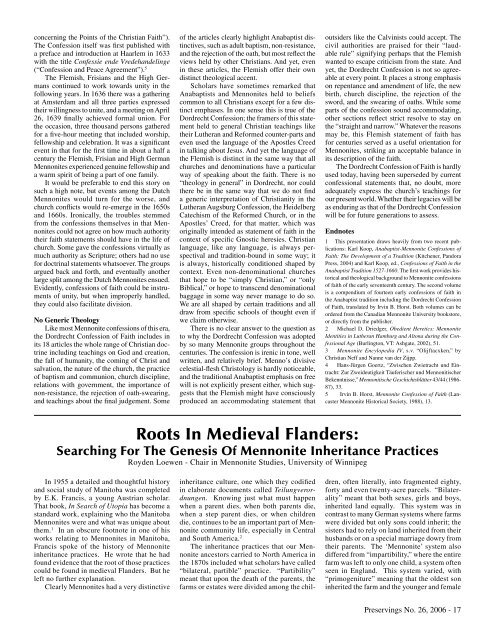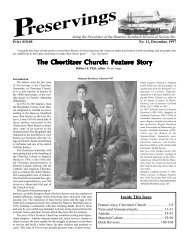Preservings $20 Issue No. 26, 2006 - Home at Plett Foundation
Preservings $20 Issue No. 26, 2006 - Home at Plett Foundation
Preservings $20 Issue No. 26, 2006 - Home at Plett Foundation
Create successful ePaper yourself
Turn your PDF publications into a flip-book with our unique Google optimized e-Paper software.
concerning the Points of the Christian Faith”).<br />
The Confession itself was first published with<br />
a preface and introduction <strong>at</strong> Haarlem in 1633<br />
with the title Confessie ende Vredehandelinge<br />
(“Confession and Peace Agreement”). 5<br />
The Flemish, Frisians and the High Germans<br />
continued to work towards unity in the<br />
following years. In 1636 there was a g<strong>at</strong>hering<br />
<strong>at</strong> Amsterdam and all three parties expressed<br />
their willingness to unite, and a meeting on April<br />
<strong>26</strong>, 1639 finally achieved formal union. For<br />
the occasion, three thousand persons g<strong>at</strong>hered<br />
for a five-hour meeting th<strong>at</strong> included worship,<br />
fellowship and celebr<strong>at</strong>ion. It was a significant<br />
event in th<strong>at</strong> for the first time in about a half a<br />
century the Flemish, Frisian and High German<br />
Mennonites experienced genuine fellowship and<br />
a warm spirit of being a part of one family.<br />
It would be preferable to end this story on<br />
such a high note, but events among the Dutch<br />
Mennonites would turn for the worse, and<br />
church conflicts would re-emerge in the 1650s<br />
and 1660s. Ironically, the troubles stemmed<br />
from the confessions themselves in th<strong>at</strong> Mennonites<br />
could not agree on how much authority<br />
their faith st<strong>at</strong>ements should have in the life of<br />
church. Some gave the confessions virtually as<br />
much authority as Scripture; others had no use<br />
for doctrinal st<strong>at</strong>ements wh<strong>at</strong>soever. The groups<br />
argued back and forth, and eventually another<br />
large split among the Dutch Mennonites ensued.<br />
Evidently, confessions of faith could be instruments<br />
of unity, but when improperly handled,<br />
they could also facilit<strong>at</strong>e division.<br />
<strong>No</strong> Generic Theology<br />
Like most Mennonite confessions of this era,<br />
the Dordrecht Confession of Faith includes in<br />
its 18 articles the whole range of Christian doctrine<br />
including teachings on God and cre<strong>at</strong>ion,<br />
the fall of humanity, the coming of Christ and<br />
salv<strong>at</strong>ion, the n<strong>at</strong>ure of the church, the practice<br />
of baptism and communion, church discipline,<br />
rel<strong>at</strong>ions with government, the importance of<br />
non-resistance, the rejection of o<strong>at</strong>h-swearing,<br />
and teachings about the final judgement. Some<br />
of the articles clearly highlight Anabaptist distinctives,<br />
such as adult baptism, non-resistance,<br />
and the rejection of the o<strong>at</strong>h, but most reflect the<br />
views held by other Christians. And yet, even<br />
in these articles, the Flemish offer their own<br />
distinct theological accent.<br />
Scholars have sometimes remarked th<strong>at</strong><br />
Anabaptists and Mennonites held to beliefs<br />
common to all Christians except for a few distinct<br />
emphases. In one sense this is true of the<br />
Dordrecht Confession; the framers of this st<strong>at</strong>ement<br />
held to general Christian teachings like<br />
their Lutheran and Reformed counter-parts and<br />
even used the language of the Apostles Creed<br />
in talking about Jesus. And yet the language of<br />
the Flemish is distinct in the same way th<strong>at</strong> all<br />
churches and denomin<strong>at</strong>ions have a particular<br />
way of speaking about the faith. There is no<br />
“theology in general” in Dordrecht, nor could<br />
there be in the same way th<strong>at</strong> we do not find<br />
a generic interpret<strong>at</strong>ion of Christianity in the<br />
Lutheran Augsburg Confession, the Heidelberg<br />
C<strong>at</strong>echism of the Reformed Church, or in the<br />
Apostles’ Creed, for th<strong>at</strong> m<strong>at</strong>ter, which was<br />
originally intended as st<strong>at</strong>ement of faith in the<br />
context of specific Gnostic heresies. Christian<br />
language, like any language, is always perspectival<br />
and tradition-bound in some way; it<br />
is always, historically conditioned shaped by<br />
context. Even non-denomin<strong>at</strong>ional churches<br />
th<strong>at</strong> hope to be “simply Christian,” or “only<br />
Biblical,” or hope to transcend denomin<strong>at</strong>ional<br />
baggage in some way never manage to do so.<br />
We are all shaped by certain traditions and all<br />
draw from specific schools of thought even if<br />
we claim otherwise.<br />
There is no clear answer to the question as<br />
to why the Dordrecht Confession was adopted<br />
by so many Mennonite groups throughout the<br />
centuries. The confession is irenic in tone, well<br />
written, and rel<strong>at</strong>ively brief. Menno’s divisive<br />
celestial-flesh Christology is hardly noticeable,<br />
and the traditional Anabaptist emphasis on free<br />
will is not explicitly present either, which suggests<br />
th<strong>at</strong> the Flemish might have consciously<br />
produced an accommod<strong>at</strong>ing st<strong>at</strong>ement th<strong>at</strong><br />
outsiders like the Calvinists could accept. The<br />
civil authorities are praised for their “laudable<br />
rule” signifying perhaps th<strong>at</strong> the Flemish<br />
wanted to escape criticism from the st<strong>at</strong>e. And<br />
yet, the Dordrecht Confession is not so agreeable<br />
<strong>at</strong> every point. It places a strong emphasis<br />
on repentance and amendment of life, the new<br />
birth, church discipline, the rejection of the<br />
sword, and the swearing of o<strong>at</strong>hs. While some<br />
parts of the confession sound accommod<strong>at</strong>ing,<br />
other sections reflect strict resolve to stay on<br />
the “straight and narrow.” Wh<strong>at</strong>ever the reasons<br />
may be, this Flemish st<strong>at</strong>ement of faith has<br />
for centuries served as a useful orient<strong>at</strong>ion for<br />
Mennonites, striking an acceptable balance in<br />
its description of the faith.<br />
The Dordrecht Confession of Faith is hardly<br />
used today, having been superseded by current<br />
confessional st<strong>at</strong>ements th<strong>at</strong>, no doubt, more<br />
adequ<strong>at</strong>ely express the church’s teachings for<br />
our present world. Whether their legacies will be<br />
as enduring as th<strong>at</strong> of the Dordrecht Confession<br />
will be for future gener<strong>at</strong>ions to assess.<br />
Endnotes<br />
1 This present<strong>at</strong>ion draws heavily from two recent public<strong>at</strong>ions:<br />
Karl Koop, Anabaptist-Mennonite Confessions of<br />
Faith: The Development of a Tradition (Kitchener, Pandora<br />
Press, 2004) and Karl Koop, ed., Confessions of Faith in the<br />
Anabaptist Tradition 1527-1660. The first work provides historical<br />
and theological background to Mennonite confessions<br />
of faith of the early seventeenth century. The second volume<br />
is a compendium of fourteen early confessions of faith in<br />
the Anabaptist tradition including the Dordrecht Confession<br />
of Faith, transl<strong>at</strong>ed by Irvin B. Horst. Both volumes can be<br />
ordered from the Canadian Mennonite University bookstore,<br />
or directly from the publisher.<br />
2 Michael D. Driedger, Obedient Heretics: Mennonite<br />
Identities in Lutheran Hamburg and Altona during the Confessional<br />
Age (Burlington, VT: Ashg<strong>at</strong>e, 2002), 51.<br />
3 Mennonite Encylopedia IV, s.v. “Olijftacxken,” by<br />
Christian Neff and Nanne van der Zijpp.<br />
4 Hans-Jürgen Goertz, “Zwischen Zwietracht und Eintracht:<br />
Zur Zweideutigkeit Täuferischer und Mennonitischer<br />
Bekenntnisse,” Mennonitische Geschichtsblätter 43/44 (1986-<br />
87), 33.<br />
5 Irvin B. Horst, Mennonite Confession of Faith (Lancaster<br />
Mennonite Historical Society, 1988), 13.<br />
Roots In Medieval Flanders:<br />
Searching For The Genesis Of Mennonite Inheritance Practices<br />
Royden Loewen - Chair in Mennonite Studies, University of Winnipeg<br />
In 1955 a detailed and thoughtful history<br />
and social study of Manitoba was completed<br />
by E.K. Francis, a young Austrian scholar.<br />
Th<strong>at</strong> book, In Search of Utopia has become a<br />
standard work, explaining who the Manitoba<br />
Mennonites were and wh<strong>at</strong> was unique about<br />
them. 1 In an obscure footnote in one of his<br />
works rel<strong>at</strong>ing to Mennonites in Manitoba,<br />
Francis spoke of the history of Mennonite<br />
inheritance practices. He wrote th<strong>at</strong> he had<br />
found evidence th<strong>at</strong> the root of those practices<br />
could be found in medieval Flanders. But he<br />
left no further explan<strong>at</strong>ion.<br />
Clearly Mennonites had a very distinctive<br />
inheritance culture, one which they codified<br />
in elabor<strong>at</strong>e documents called Teilungverordnungen.<br />
Knowing just wh<strong>at</strong> must happen<br />
when a parent dies, when both parents die,<br />
when a step parent dies, or when children<br />
die, continues to be an important part of Mennonite<br />
community life, especially in Central<br />
and South America. 2<br />
The inheritance practices th<strong>at</strong> our Mennonite<br />
ancestors carried to <strong>No</strong>rth America in<br />
the 1870s included wh<strong>at</strong> scholars have called<br />
“bil<strong>at</strong>eral, partible” practice. “Partibility”<br />
meant th<strong>at</strong> upon the de<strong>at</strong>h of the parents, the<br />
farms or est<strong>at</strong>es were divided among the children,<br />
often literally, into fragmented eighty,<br />
forty and even twenty-acre parcels. “Bil<strong>at</strong>erality”<br />
meant th<strong>at</strong> both sexes, girls and boys,<br />
inherited land equally. This system was in<br />
contrast to many German systems where farms<br />
were divided but only sons could inherit; the<br />
sisters had to rely on land inherited from their<br />
husbands or on a special marriage dowry from<br />
their parents. The ‘Mennonite’ system also<br />
differed from “impartibility,” where the entire<br />
farm was left to only one child, a system often<br />
seen in England. This system varied, with<br />
“primogeniture” meaning th<strong>at</strong> the oldest son<br />
inherited the farm and the younger and female<br />
<strong>Preservings</strong> <strong>No</strong>. <strong>26</strong>, <strong>2006</strong> - 17
















